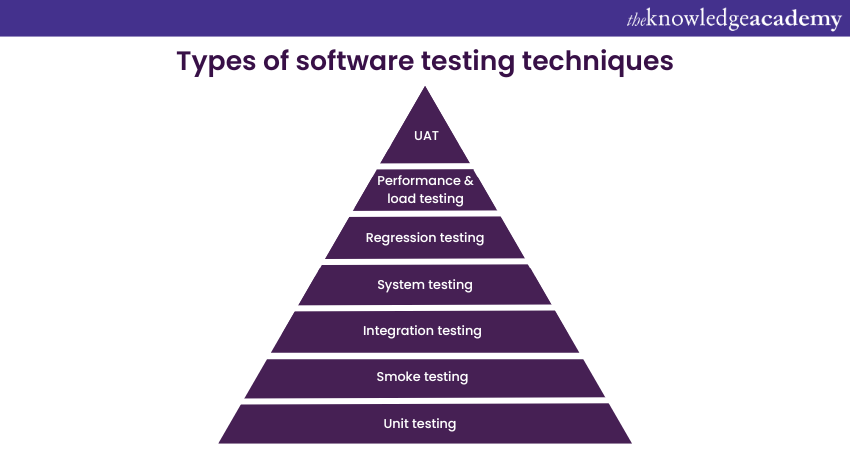We may not have the course you’re looking for. If you enquire or give us a call on +1 6474932992 and speak to our training experts, we may still be able to help with your training requirements.
Training Outcomes Within Your Budget!
We ensure quality, budget-alignment, and timely delivery by our expert instructors.

In the domain of software development, quality is paramount. As the demand for quality products increases, Software Testing Techniques come in handy, requiring comprehensive and sound techniques to avoid any last-minute rush. These techniques make the life of a software engineer much more comfortable. Software Testing is a crucial process that aims to identify defects, ensure overall functionality and enhance the user experience.
A triumphant and path-breaking test strategy is not a secret sauce anymore while we begin with consideration during requirements specification. Embracing effective testing practices fosters a quality culture and enables software development teams to produce exceptional products that meet and exceed user experience.
So, let's dig deep into Software Testing to understand its core principles and explore various testing methods that formulate a robust Software Testing strategy and how Software Testing Techniques help design better solutions. Read this complete blog to learn and understand about software testing techniques, types of testing techniques, advantages, and disadvantages.
Table of Contents
1) What is Software Testing?
2) What are Software Testing Techniques?
3) Types of Software Testing Techniques
4) Advantages of Software Testing Techniques
5) Disadvantages of Software Testing Techniques
6) Conclusion
What is Software Testing?
Software Testing is a systematic technique of reviewing software to find defects and ensure that they match the specifications of the application. It entails running software under controlled conditions to identify defects or issues, which are subsequently reported, tracked, and resolved. Testing ensures that the program works properly, performs as planned, and provides an acceptable user experience.
What are Software Testing Techniques?
Software Testing is the process of checking and conforming a program, application or software to identify any technical glitch or bug, for that matter. Before the system is made available to be launched in the open market, the software should undergo various testing phases to find any sort of bug in the system.
Testing the software's usability using various techniques helps determine how user-friendly and agile that software is for the end user. A term has been coined in recent times called User Acceptability Testing (UTA), which is held responsible for running the program that satisfies the needs and expectations of the end user in any given category.
Types of Software Testing Techniques
Software Testing Techniques strive to mark the optimism required in assessing software quality, which is suitable for mass users, particularly in the case of mission-critical systems.
To enhance the agility and user-friendliness of our software, the testing must be done thoroughly with the help of various testing methods to eliminate all sorts of fallacy from the program. The following are some of the commonly used Software Testing Techniques:

Unit testing
Unit testing is the foundational level of testing, focusing on individual units or components of the software. The goal is to verify that each unit functions correctly in an individual capacity. Developers often perform unit testing, facilitating early bug detection, simplifying debugging and helping maintain code quality. It also ensures that any coding modification does not infuse new bugs in the system.
Integration testing
Integration testing, also known as functional testing, ensures all the interrelated units of a software application connect well. This testing format is designed to validate the software's functionality by comparing its expected behaviour with the actual one. It ensures that the software meets specified requirements and functions as intended. The main advantage of integration testing is that it helps identify issues when different software units are performing together, improving the overall accuracy and safety of the software application.
Example:
Black box testing: It is used for authentication. In this, we ignore internal working mechanisms and focus on what is the outcome.
White box testing: It is used for affirmation. In this, we focus on internal mechanisms to know how the outcome is accomplished.
Regression testing
Regression testing involves rerunning tests on modified or updated software applications to ensure that changes made earlier to the software do not infuse new bugs into the system or adversely affect the existing functionality. Regression testing can be formalised into three categories:
a) Retesting
b) Resection
c) Comparison
This testing methodology ensures the quality of the product lifecycle and helps software applications to run smoothly as expected.
Get certified with our ISTQB Software Testing Foundation Course today!
Smoke testing
Smoke testing is executed to ensure that the software application that underwent testing is all set for advanced levels of testing. For instance, if the project has two modules, the testing department must ensure that module 1 is working fine and does not clash.
Alpha testing
Alpha testing is normally done by QA (quality analysts), where acceptance testing is performed before the product is launched to end users. For example, software or product testing is executed among the employees within the organisation's boundaries and gets feedback from them.
Beta testing
Beta testing is nothing but a pre-launch test of the product where the software application goes into the hands of selected end users, and their feedback is incorporated to improve the user quality of the software. This testing phase is coined as a beta version of the software when Software Testing is performed for a small number of users in a real-time environment.
System testing
System testing is done on the entire system under either functional or system requirement specifications or guidance from both. The software must be thoroughly tested to ensure it runs well on all operating systems, including the black box testing methodology. Under this system testing, we only pay attention to the necessary input and output. For instance, testing that is both functional and non-functional is covered in this segment of testing.
Stress testing
This is a very small testing scale where we input critical path conditions to the system and observe how they perform in those scenarios.
Example: A website experiencing many users gets overloaded by an unexpected increase in web traffic.
Performance testing
Performance testing is one of the crucial Software Testing Techniques that is intended to test how well software performs when used in the context of an integrated system. It is imbibed in the system to evaluate the efficiency and speed of the program. Another name for it is load testing, where we examine the system's performance under the specified load.
Object-oriented testing
This testing combines several testing methodologies that aid in verifying and validating object-oriented software. The testing is carried out following certain footsteps like testing requirements, a test of designs and analysis, a test of code, a test of integration, a test of systems, and finally, a test of users. By following all the necessary steps, one can achieve the desired results.
Master Software Testing Interview Questions: Ace Your Next Opportunity! Start Today!
Acceptance testing
In this part of Software Testing, customers do acceptance testing to determine whether the provided product fulfils the requirements and performs the expected duties. The term coined as User Acceptability Testing (UAT) is carried out by the client himself, the domain expert, or the customer.
User acceptability testing is knowing the application inside out before accepting the finished software as a product or service. In user acceptance testing, we examine the real world and business scenarios in a special setting known as the UAT environment to avoid any kind of uncertainty in the application.
Master the art of seamless software quality with our Software Testing And Automation Course – Sign up now!
Advantages of Software Testing Techniques
The following are the advantages of Software Testing Techniques:
a) Improved software quality: By thoroughly testing software components, developers can ensure that the product meets quality standards and needs. This results in increased customer satisfaction and a lower risk of software problems in production.
b) Increased efficiency: Testing approaches help developers save time and effort by automating the testing process. Automated tests can be run multiple times, providing faster feedback on code changes and enabling continuous integration and delivery techniques.
c) Cost savings: Detecting and resolving imperfections early in the development process is less expensive than addressing them later. Testing approaches serve to reduce the overall cost of Software Development by limiting defect escalation and decreasing rework.
d) Improved User Experience: Software Testing Techniques help in identifying usability issues and user interface problems, leading to improvements in the overall user experience.
Explore Software Tester Salary: Maximize Your Earnings. Discover More Now!
Disadvantages of Software Testing Techniques
a) The following are the disadvantages of Software Testing Techniques: Expensive and time-consuming: Comprehensive testing can be time-consuming and expensive, especially when you consider the resources needed for test planning, execution, and maintenance. The costs of setting up testing environments, purchasing testing equipment, and recruiting competent testers can all be significant.
b) Complexity: As software systems become more complicated, creating and performing effective testing becomes more difficult. Test scenarios require considering many variables and edge cases, which increases the complexity of test design and execution processes.
c) Maintenance overhead: To be effective as software develops, test suites must be maintained on an ongoing basis. Modifying existing test cases due to changes in software functionality or architecture can be time-consuming and resource intensive.
d) Measuring effectiveness: It can be difficult to accurately analyse the effectiveness of testing methodologies. Metrics like code coverage and defect density only provide limited information about testing quality.
Master Automation Testing using TestComplete! Enhance your skills, streamline your testing processes, and achieve efficiency. Join today!
Conclusion
Software Testing Techniques are an indispensable part of the Software Development Life Cycle. By adhering to the core principles of testing and employing various testing methodologies, developers and testers can ensure the delivery of high-quality, reliable, and user-friendly software.
Advance your Automation Testing skills with JUnit 5 by registering in Automation Testing With JUnit 5 Course
Frequently Asked Questions

Testing Techniques refer to methods and approaches for designing and executing tests, while testing tools are software applications used to automate, manage, or support the testing process.

The Testing Life Cycle (TLC) is a process that defines the various stages involved in testing software applications, from planning to execution and reporting of test activities.

The Knowledge Academy takes global learning to new heights, offering over 30,000 online courses across 490+ locations in 220 countries. This expansive reach ensures accessibility and convenience for learners worldwide.
Alongside our diverse Online Course Catalogue, encompassing 17 major categories, we go the extra mile by providing a plethora of free educational Online Resources like News updates, Blogs, videos, webinars, and interview questions. Tailoring learning experiences further, professionals can maximise value with customisable Course Bundles of TKA.

The Knowledge Academy’s Knowledge Pass, a prepaid voucher, adds another layer of flexibility, allowing course bookings over a 12-month period. Join us on a journey where education knows no bounds.

The Knowledge Academy offers various Software Testing Course, including Certified Software Testing Professional (CSTP), Certified Software Testing Manager (CSTM), Unit Testing Course and Manual Testing Training. These courses cater to different skill levels, providing comprehensive insights into Test Management Tools.
Our Business Analysis Blogs cover a range of topics related to Software Testing, offering valuable resources, best practices, and industry insights. Whether you are a beginner or looking to advance your Business Analysis skills, The Knowledge Academy's diverse courses and informative blogs have you covered.







 Top Rated Course
Top Rated Course




 If you wish to make any changes to your course, please
If you wish to make any changes to your course, please


